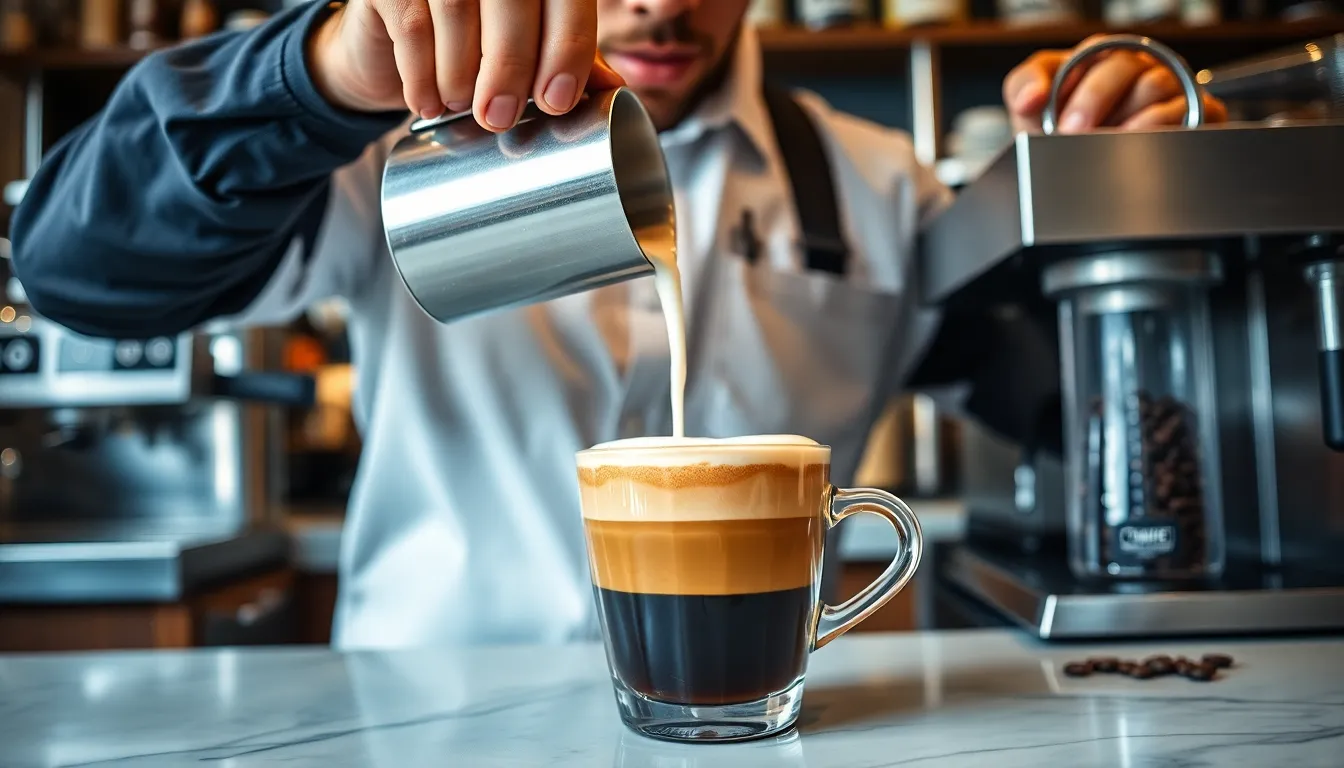What’s the perfect cappuccino milk ratio that baristas swear by? Mastering this crucial balance can transform your morning coffee from mediocre to magnificent.
The classic cappuccino follows the rule of thirds: equal parts espresso, steamed milk, and milk foam. But within this seemingly simple formula lies the art of creating the perfect cup. Many coffee enthusiasts struggle with achieving that velvety texture and rich flavor that makes cappuccinos so beloved worldwide.
Whether you’re a home barista looking to perfect your technique or simply curious about what goes into your favorite café drink, understanding the ideal milk-to-coffee ratio is essential. You’ll discover how slight adjustments can dramatically alter both taste and texture, and why temperature matters just as much as proportion.
What Is a Cappuccino: Understanding the Basics
A cappuccino represents one of the most iconic espresso-based drinks in the coffee industry, characterized by its distinctive layered composition. The classic cappuccino follows the “rule of thirds” – equal parts espresso, steamed milk, and milk foam, creating a balanced 1:1:1 ratio. This traditional Italian beverage originated in the early 20th century and has evolved into a globally beloved coffee drink.
The foundation of every cappuccino starts with a shot of espresso (about 30ml), providing a rich, concentrated coffee base. On top of this foundation sits steamed milk (also about 30ml), which adds creaminess and tempers the intensity of the espresso. The final component, milk foam (approximately 30ml), creates that characteristic fluffy top layer that gives cappuccinos their signature look and texture.
“I’ve been crafting cappuccinos for over 15 years, and the beauty lies in that perfect harmony between the three elements,” shares Rikki Manny. “Many customers tell me they can immediately taste when the ratio is off, even if they can’t explain exactly why.”
The perfect cappuccino delivers a harmonious drinking experience where the boldness of espresso balances with the sweetness of milk, while the foam adds a luxurious mouthfeel. Temperature plays a crucial role too – ideally served at 160°F (71°C), hot enough to develop the milk’s natural sweetness without scalding it.
Understanding this basic structure helps you appreciate why the milk ratio matters so much. Each element contributes exact qualities to the final drink, and altering any component significantly changes the cappuccino’s character, flavor profile, and texture.
The Perfect Cappuccino Milk Ratio Explained

The ideal cappuccino balances distinct elements in perfect harmony, creating that signature taste coffee lovers crave. Understanding the proper milk ratios transforms an ordinary coffee experience into an exceptional one.
The Traditional 1:1:1 Formula
The classic cappuccino follows a precise 1:1:1 ratio that coffee purists consider the gold standard. This traditional formula divides your cappuccino into equal thirds: one-third espresso (about 25 ml), one-third steamed milk (approximately 85 ml), and one-third milk foam. A properly prepared cappuccino typically measures around 150 ml (5 oz) in total volume, with the foaming process adding that extra dimension through aeration. This balanced composition delivers a harmonious taste experience where the robust espresso flavor, creamy milk texture, and light frothiness complement each other without any single element dominating the palate.
Modern Variations in Cappuccino Milk Ratios
Contemporary coffee culture has embraced several adaptations to the traditional cappuccino ratio, catering to diverse preferences and coffee bean characteristics. Lighter roast espressos often pair better with increased milk proportions, such as 1:2.5 or 1:3 (espresso to milk), which helps moderate perceived bitterness while maintaining flavor complexity. Coffee shops now commonly offer “wet” cappuccinos containing more steamed milk and reduced foam for a creamier experience, alongside “dry” cappuccinos featuring an airier, more substantial foam layer for those who prefer a lighter texture. These modifications provide customization options while preserving the fundamental principle that milk should enhance rather than overwhelm the espresso’s character. Regional preferences across different coffee cultures continue to introduce subtle variations, making the cappuccino both a timeless classic and an evolving art form in the specialty coffee industry.
How Milk Type Affects Your Cappuccino

The milk you choose dramatically influences your cappuccino’s texture, flavor profile, and foam stability. Different milk varieties create distinct drinking experiences while maintaining the classic cappuccino structure.
Whole Milk vs. Skim Milk
Whole milk produces the gold standard cappuccino experience with its rich fat content creating a velvety, stable foam that holds its structure throughout your drinking experience. The higher fat percentage (typically 3.25%) results in a creamy mouthfeel and fuller body that complements the espresso’s intensity perfectly. Many specialty coffee shops prefer whole milk for cappuccinos because it creates that luxurious microfoam that’s both stable and silky.
Skim milk takes your cappuccino in a lighter direction, producing airier, more voluminous foam due to its higher protein-to-fat ratio. The resulting cappuccino has a less creamy texture and thinner body compared to whole milk versions. Foam from skim milk tends to dissipate faster and lacks the structural integrity that makes whole milk cappuccinos so satisfying. Skim milk cappuccinos offer fewer calories but sacrifice some of the rich mouthfeel that defines the classic cappuccino experience.
Plant-Based Alternatives and Their Ratios
Plant-based milks require careful consideration when crafting cappuccinos as they behave differently during steaming and frothing. Oat milk stands out among non-dairy alternatives, producing creamy foam relatively similar to whole milk when steamed properly. Its natural sweetness and neutral flavor profile make it an excellent complement to espresso while maintaining the traditional 1:1:1 cappuccino ratio.
Almond milk creates a lighter cappuccino with a distinctive nutty flavor, though its foam tends to be less stable and more watery than dairy counterparts. Baristas often adjust the milk volume slightly when using plant-based alternatives to compensate for variations in foam stability and texture. Even though these adjustments, the fundamental cappuccino principle of balancing espresso, steamed milk, and foam remains intact, preserving the classic experience while accommodating dietary preferences and restrictions.
When working with any plant-based milk, paying attention to barista-exact formulations helps achieve better results as these versions are specifically developed to steam and froth similarly to dairy milk. The perfect plant-based cappuccino maintains the traditional ratio structure while embracing the unique characteristics each alternative milk brings to your cup.
Temperature and Texture: Keys to Proper Milk Steaming

Temperature and texture form the foundation of properly steamed milk for a cappuccino. Mastering these elements transforms ordinary milk into the velvety microfoam that defines a perfect cappuccino experience.
Achieving the Ideal Microfoam
Microfoam consists of extremely fine, uniform bubbles that create a silky, creamy texture without large air pockets. This smooth consistency resembles wet paint—glossy and uniform throughout. Quality microfoam requires careful attention to both the milk’s temperature and the steaming technique.
When steaming milk for a cappuccino, aim for a temperature between 150°F and 160°F (65°C-71°C). Exceeding this temperature range risks scalding the milk, which destroys its natural sweetness and creates an unpleasant burnt flavor. The sweet spot around 155°F maximizes the milk’s natural sugars without compromising texture.
Proper steaming technique involves a two-phase approach. First, position the steam wand just below the milk’s surface to introduce air, creating that essential microfoam. Then submerge the wand deeper to circulate and heat the milk evenly throughout the pitcher. This circulation distributes the microscopic air bubbles evenly, creating the velvety texture that cappuccino lovers crave.
Whole milk produces the most consistent results due to its optimal fat and protein content. The fat creates richness while the proteins stabilize the foam structure. Your espresso quality matters equally—a well-extracted shot with a 1:2 coffee-to-water ratio provides the perfect foundation for your carefully steamed milk.
Equipment plays a crucial role in achieving perfect microfoam. A quality espresso machine with a powerful steam wand gives you precise control over both pressure and temperature. Many home baristas find that investing in a proper milk pitcher with a pointed spout helps create the ideal whirlpool effect during steaming, resulting in more consistent microfoam.
The microfoam’s integration with espresso creates the signature cappuccino experience—where robust coffee flavors meld with creamy milk in perfect harmony. When poured correctly, the microfoam should fold into the espresso rather than floating separately, creating distinct layers that gradually blend together as you enjoy the drink.
Common Cappuccino Milk Ratio Mistakes to Avoid

Achieving the perfect cappuccino requires precision in your milk-to-coffee ratio. Many coffee enthusiasts unknowingly compromise their brew by making these common mistakes.
Adding Too Much Milk
Excessive steamed milk dilutes your espresso’s robust flavor profile. When you pour more than the recommended 2 ounces (60-85 ml) of steamed milk into a standard 6-ounce cappuccino, you’re creating an imbalanced drink where the coffee notes become weak and understated. The rich intensity that defines a proper cappuccino disappears, leaving you with something closer to a latte than the classic Italian beverage.
Skimping on Foam
Insufficient milk foam robs your cappuccino of its characteristic texture and mouthfeel. The ideal cappuccino includes approximately 2 ounces (60 ml) of foamed milk, creating that distinctive light, airy top layer. Cutting corners on foam transforms your drink into something entirely different—perhaps a flat white or café au lait—but certainly not an authentic cappuccino with its signature velvety finish.
Creating Incorrect Foam Density
Foam consistency dramatically impacts your cappuccino experience. “Wet” cappuccinos contain more steamed milk and less foam, creating a creamier, heavier texture. “Dry” cappuccinos feature more foam and less steamed milk, resulting in a lighter drink with pronounced separation between layers. Neither variation is wrong, but straying too far from the traditional balance alters the fundamental cappuccino character and drinking experience.
Using Oversized Cups
Cup size significantly affects your cappuccino’s flavor balance. Traditional cappuccinos are served in 5-6 ounce cups to maintain proper component ratios. Using larger vessels while keeping the standard 1-ounce espresso shot dilutes the coffee flavor throughout more milk, compromising the drink’s intensity. The classic 1:1:1 ratio (espresso:steamed milk:foam) works specifically because it’s designed for smaller cups where each element can shine.
Neglecting Roast Characteristics
Different coffee roasts require subtle ratio adjustments. Lighter roasts typically benefit from slightly more milk (closer to a 1:2.5 ratio) to balance their natural acidity, while darker roasts pair better with the traditional 1:1:1 proportion to complement their boldness without overwhelming it. Treating all espresso varieties with identical milk ratios overlooks their unique flavor profiles and can result in an unbalanced cappuccino.
Tools for Measuring the Perfect Cappuccino Milk Ratio

Achieving the classic 1:1:1 cappuccino ratio requires precision tools that help maintain consistency with each cup you brew. Espresso shot timers ensure your extraction hits the sweet spot of approximately 36 grams from 18 grams of coffee grounds. Digital scales provide accuracy when measuring both your coffee dose and espresso yield, eliminating guesswork and creating a solid foundation for your cappuccino.
Milk thermometers are essential for monitoring steaming temperatures between 150°F and 160°F, where milk’s natural sweetness peaks without scalding. Properly sized milk pitchers with clear volume markings help control both the quantity of milk and create the appropriate space for texturing during the steaming process. Many professional baristas use pitchers with internal measurement lines specifically designed for portioning milk according to different drink recipes.
Specialized cappuccino cups ranging from 150-160 ml (5-5.5 oz) naturally guide proper portioning of each component: 50 ml espresso, 50 ml steamed milk, and 50 ml foam. Several smartphone applications and online calculators now exist specifically for coffee enthusiasts, helping optimize milk-to-espresso ratios based on different shot sizes and brew strengths. These digital tools calculate precise measurements for consistent results, whether you’re making a single cappuccino or serving multiple variations throughout the day.
For home baristas seeking professional-level consistency, ratio scales with built-in timers offer multi-functional assistance, monitoring both your espresso extraction time and the weight of each component as you build your cappuccino. Temperature-controlled milk steamers with programmable settings help eliminate one variable from the equation, ensuring your milk reaches the ideal temperature for microfoam development every time.
How Baristas Adjust Milk Ratios for Different Cappuccino Styles

Professional baristas regularly modify the classic 1:1:1 cappuccino ratio to accommodate different cup sizes, coffee strengths, and customer preferences. These adjustments maintain the essence of a cappuccino while creating distinct variations that appeal to diverse palates.
American vs. European Style Cappuccinos
American-style cappuccinos typically come in larger 12 oz cups with approximately 2 oz of espresso, 6-7 oz of steamed milk, and 3-4 oz of foam. This modification results in a milkier, less intense coffee experience compared to traditional European cappuccinos. European cappuccinos stay true to the classic 160 ml (6 oz) size with equal thirds of espresso, steamed milk, and foam, delivering a more concentrated coffee flavor.
Wet and Dry Cappuccino Variations
Baristas adjust the milk-to-foam ratio to create “wet” and “dry” cappuccino variations:
- Wet cappuccinos contain more steamed milk and less foam, creating a creamier, smoother texture with a slightly diluted espresso flavor
- Dry cappuccinos feature more foam and less steamed milk, emphasizing the espresso’s intensity while maintaining a lighter mouthfeel
These modifications still use the same amount of espresso but alter the proportions of steamed milk and foam to achieve different textural experiences.
Adjusting for Coffee Strength and Roast Profile
Expert baristas fine-tune milk ratios based on the coffee’s roast profile and extraction style:
- Dark roasts with robust, bold flavors often pair well with slightly more milk (1:1.2:1 ratio) to balance intensity
- Light roasts with brighter, more acidic notes may benefit from less milk (1:0.8:1 ratio) to highlight the coffee’s complexity
- Ristretto shots (18-21.5 grams of coffee yielding 36 ml) typically receive less milk than regular shots to preserve their concentrated character
These subtle adjustments ensure the milk enhances rather than masks the espresso’s distinctive characteristics.
Regional and Cultural Adaptations
Cappuccino styles vary significantly across different coffee cultures:
- Italian traditional approach strictly adheres to the 1:1:1 ratio in small cups, served primarily as a morning beverage
- Australian flat white-inspired cappuccinos often reduce foam volume for a silkier, more milk-forward experience
- Specialty coffee shops might adjust ratios based on bean origin, creating custom profiles that highlight exact flavor notes
These regional preferences demonstrate how the cappuccino continues to evolve while maintaining its fundamental identity as a balanced espresso and milk beverage.
Conclusion
Getting your cappuccino milk ratio right transforms an ordinary coffee experience into something extraordinary. Whether you stick with the classic 1:1:1 formula or experiment with “wet” or “dry” variations you’re now equipped to create cafe-quality drinks at home.
Remember that your choice of milk significantly impacts the final result. Invest in basic tools like a thermometer and properly sized pitcher to achieve consistency with every cup.
Don’t be afraid to adjust ratios based on your espresso’s characteristics or personal preference. The perfect cappuccino balances bold coffee flavors with creamy milk texture in harmony.
With practice you’ll develop an intuition for milk steaming that elevates your morning ritual from simple caffeine fix to artisanal indulgence.
Frequently Asked Questions
What is the classic ratio for a perfect cappuccino?
The classic cappuccino follows the rule of thirds: equal parts espresso, steamed milk, and milk foam (1:1:1). This balanced composition creates a harmonious 150 ml (5 oz) beverage where robust espresso flavor, creamy milk texture, and light frothiness complement each other perfectly.
How does milk type affect cappuccino quality?
Whole milk is the gold standard for cappuccinos due to its fat content creating velvety, stable foam. Skim milk produces lighter, airier foam but lacks creaminess. Among plant-based alternatives, oat milk performs best with foam similar to whole milk, while almond milk offers a nuttier flavor but less stable foam.
What is the ideal temperature for cappuccino milk?
The ideal temperature for cappuccino milk is between 150°F and 160°F (65°C-71°C), with 160°F (71°C) being optimal. This temperature range enhances milk’s natural sweetness without scalding it. Proper temperature is crucial for developing the microfoam texture that defines a quality cappuccino.
What are “wet” and “dry” cappuccinos?
A “wet” cappuccino contains more steamed milk and less foam, resulting in a creamier, heavier texture. A “dry” cappuccino has less steamed milk and more foam, creating a lighter, fluffier drink with a more pronounced espresso flavor. Both variations maintain the same amount of espresso but alter the milk-to-foam ratio.
How do cup sizes affect cappuccino ratios?
Cup size significantly impacts cappuccino quality. Traditional cappuccinos are served in 5-6 oz cups to maintain the 1:1:1 ratio. Larger cups require adjusting ratios to prevent diluting the espresso. Using appropriately sized cups ensures proper flavor balance and the authentic cappuccino experience.
What tools help measure the perfect cappuccino ratio?
Essential tools include espresso shot timers, digital scales (for precise milk measurement), milk thermometers (to ensure 150-160°F temperature), properly sized milk pitchers, and specialized cappuccino cups. Digital tools like smartphone applications can also help home baristas achieve professional-level consistency.
How do American and European cappuccinos differ?
American-style cappuccinos tend to be larger (12-16 oz) and milkier, often resembling lattes. Traditional European cappuccinos are smaller (5-6 oz), adhere to the classic 1:1:1 ratio, and offer a more balanced espresso-forward experience. The European style emphasizes quality and tradition over quantity.
What’s the most common mistake when making cappuccinos?
The most common mistake is adding too much milk, which dilutes the espresso’s flavor. Other frequent errors include skimping on foam (losing the characteristic texture), overheating milk (causing scalded taste), or using improper cup sizes. Maintaining proper ratios is essential for an authentic cappuccino experience.

